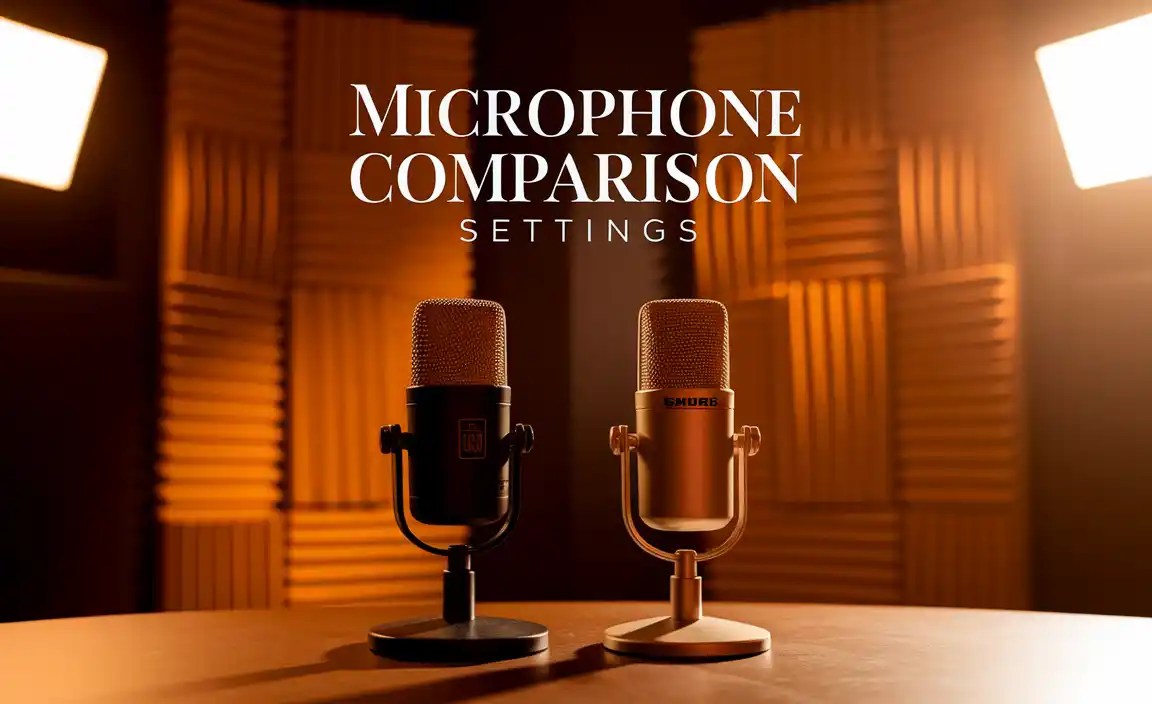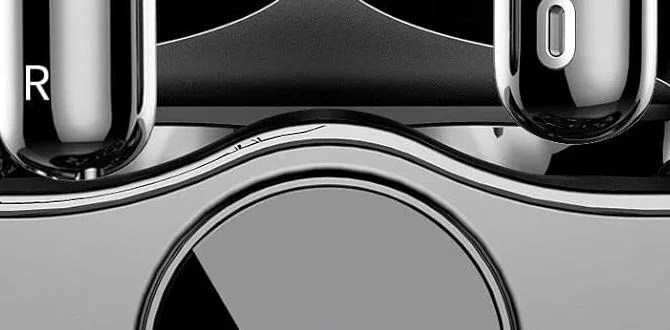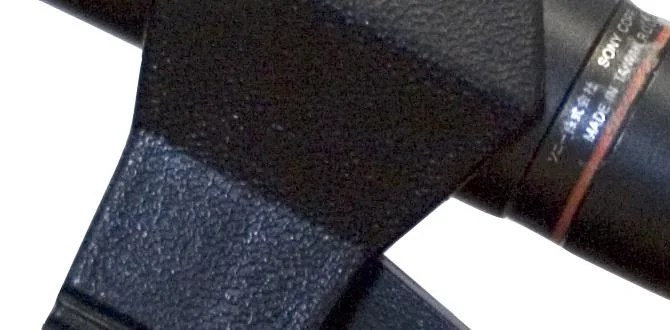Have you ever wondered how to choose the best microphone for your needs? With so many options, making a decision can seem tricky. Today, we dive into the world of microphone comparison settings.
Microphones come in different shapes and sizes. Each type has unique features. Understanding these differences can help you pick the right one. Imagine you want to record your favorite song. The best microphone can make your voice sound amazing!
Here’s a fun fact: Did you know that some famous singers use special microphones to improve their sound? This is why knowing microphone comparison settings is so important! You want to sound your best, whether you are singing, podcasting, or just having fun.
In this article, we will explore various microphone types and settings. We’ll break it down easily so everyone can understand. By the end, you will know what to look for when comparing microphones. Let’s get started!

Microphone Comparison Settings: Find The Perfect Setup

Understanding Microphone Types
Dynamic vs. Condenser Microphones. Specialized Microphones: Ribbon and Lavalier.
Microphones come in different types, like ice cream flavors, each with its own charm. Dynamic microphones are tough cookies. They handle loud sounds well, making them perfect for live performances. On the flip side, condenser microphones are the delicate flowers; they capture soft sounds and details, which is great for studios. Then we have the unique ones: ribbon microphones that are vintage and warm, and lavalier microphones, tiny clips that make you feel like a secret agent. Each type has its magic!
| Microphone Type | Best For | Fun Fact |
|---|---|---|
| Dynamic | Live Shows | Can handle loud noises! |
| Condenser | Studio Recording | Perfect for picking up whispers! |
| Ribbon | Warm Sound Quality | Vintage vibe! |
| Lavalier | Interviews | Small but mighty! |
Important Microphone Specifications
Sensitivity and Frequency Response Explained. Impedance and Its Impact on Performance.
Understanding how microphones work helps you choose the best one. Sensitivity measures how well a microphone picks up sound. A higher sensitivity means it captures softer noises better. Frequency response shows the range of sounds the mic can hear, like low bass or high notes.
Impedance affects how a microphone performs with other devices. Low impedance mics are great for longer cables, while high impedance ones may crackle over distance.
What is microphone sensitivity?
Sensitivity tells us how good a microphone is at picking up soft sounds. Higher numbers mean it hears better.
Why is frequency response important?
Frequency response shows which sounds a microphone can pick up clearly. This range helps users know what kind of sound to expect.
What does impedance mean for microphones?
Impedance is about how well a mic works with other gear. Lower impedance helps avoid sound problems over long distances.
- Sensitivity: Higher numbers = better sound capture
- Frequency Response: The range of sounds you can hear
- Impedance: Low = good for long cables, high = may cause noise
Setting Up Microphones for Optimal Recording
Positioning Techniques for Different Microphones. Acoustic Treatment: Significance in Sound Quality.
Proper microphone setup is essential for great sound. Each type of microphone has specific placement needs. For instance, a dynamic mic works best close to the sound source, while a condenser mic needs distance to catch finer details. Acoustic treatment also enhances sound quality. Soft materials, like carpets and curtains, can reduce echoes. These changes can make a big difference!
Why is positioning important for microphones?
Positioning affects sound quality directly. Placing microphones correctly can prevent unwanted noise and improve clarity. Each mic type has unique settings that work best for different environments.
Key positioning tips:
- Dynamic mics: close to the source.
- Condenser mics: a bit farther away.
- Consider room acoustics to reduce echoes.
Using the right techniques will help you record clearer and better-sounding audio!
Key Comparison Factors
Analyzing Sound Quality Across Different Environments. Comparing Microphone Features: Polar Patterns and Connectivity.
When comparing microphones, consider how they perform in different settings. Sound quality matters. Check how a microphone picks up sounds in quiet versus noisy rooms. Look for features like polar patterns, which show how well the mic picks up sound from different directions. Connectivity is also key. Does it use USB, XLR, or Bluetooth? Knowing these details helps you choose the right microphone for your needs.
What factors should I consider in microphone settings?
Important factors include sound quality, polar patterns, and connectivity options. These features define how well a microphone works in various environments.
Software and Tools for Microphone Settings Comparison
DAW Integration and Usage. Calibration Tools for Precise Adjustments.
Choosing the right software for checking microphone settings can be fun and useful! A Digital Audio Workstation (DAW) is a great start. Programs like GarageBand or Audacity let you easily record and adjust sound. Imagine having a tiny recording studio right at home! You can tweak every little detail until it sounds just right.
Calibration tools are your magic wands for precision. They help balance sounds so your voice shines bright. You wouldn’t want to sound like a robot caught in a blender, right? You can use tools like Room EQ Wizard to measure and adjust your space too!
| Tool | Purpose |
|---|---|
| GarageBand | Easy recording and mixing |
| Audacity | Free audio editing |
| Room EQ Wizard | Calibration and sound checking |
With these tools, you’ll sound like a star! So, whip out your microphone, get your software, and let the music flow.
Practical Applications of Microphone Comparisons
Selecting the Right Microphone for Music Production. Best Practices for Podcast and Streaming Setups.
Picking the right microphone can make a big difference in music production. Some mics capture sound better than others, helping your music shine. For podcasts and streaming, clarity is key. Use a mic that picks up your voice clearly to keep listeners engaged.
- Check frequency response to match your voice.
- Consider using a pop filter for cleaner sound.
- Test different mics before choosing one.
What microphone should I use for recording music?
For music recording, a condenser microphone is usually best. It picks up details well, giving your songs a polished sound.
How can I improve my podcast audio quality?
To enhance audio quality, use an adequate microphone and quiet recording space. Good lighting is also important for video streams. Keep your setup simple but effective.
Common Mistakes in Microphone Settings
Misunderstanding Gain Structure and Its Effects. Overlooking Room Acoustics When Setting Up.
Many people make common blunders when adjusting their microphones. One mistake is not understanding gain structure. If gain is too high, your sound might clip, leading to a fun but annoying “robot voice.” Also, don’t overlook room acoustics! A noisy room can make even the best microphone sound bad. Check out the table below for some quick tips!
| Common Mistakes | Effects | Solutions |
|---|---|---|
| Misunderstanding Gain | Screechy or dull sound | Adjust gain carefully |
| Ignoring Room Acoustics | Echos and background noise | Use sound panels or choose a quiet spot |
Expert Tips for Microphone Settings Optimization
Recommendations from Audio Professionals. Utilizing Technology for Enhanced Sound Quality.
Audio experts often suggest ways to get the best sound from your microphone. Here are some key tips:
- Check your environment. Quiet spaces work best.
- Adjust the gain carefully. Too high causes noise, too low loses sound.
- Use pop filters to reduce unwanted sounds.
- Experiment with different mic placements. Moving it a few inches can change everything!
Using technology can also improve sound quality. Smart software helps remove background noise and enhance your voice. Remember, even small changes can make a big difference in how clearly you are heard!
What are the best microphone settings for clarity?
For clarity, keep the gain between 50% and 70%. Make sure the mic is close to your mouth but not too close!
Conclusion
In summary, understanding microphone comparison settings helps you choose the best mic for your needs. Remember to consider sound quality, frequency response, and budget. Experimenting with settings will improve your recordings. We encourage you to explore reviews and user experiences to learn more. Happy recording and enjoy discovering the perfect microphone for your projects!
FAQs
What Are The Key Differences Between Dynamic And Condenser Microphones, And How Do Their Settings Affect Audio Quality In Different Recording Environments?
Dynamic microphones are great for loud sounds, like drums. They are tough and can handle a lot of noise. Condenser microphones are better for quiet sounds, like singing. They are more sensitive and pick up details. In a quiet room, a condenser mic can make your voice sound clearer, while a dynamic mic works well in noisy places.
How Do Microphone Polar Patterns (Cardioid, Omnidirectional, Bidirectional) Influence Mic Placement And Settings In Various Recording Scenarios?
Microphone polar patterns help us understand how sound is captured. A cardioid mic only listens from the front, which is great for recording voices and blocking noise behind it. An omnidirectional mic hears sounds from all around, so we can use it when recording a group of people or in a quiet room. A bidirectional mic picks up sound from the front and back, perfect for interviews. Choosing the right mic pattern helps us set it up just right for each situation.
What Eq Settings Are Commonly Recommended For Different Types Of Microphones To Enhance Audio Clarity And Reduce Unwanted Noise?
To make audio sound better, we can change the EQ settings on microphones. For talking, boost the mid-range a little. This helps your voice stand out. For singing, add some highs to make it brighter. If there’s a lot of background noise, lower the low sounds to make it quieter.
How Does The Impedance Of A Microphone Affect Its Compatibility With Audio Interfaces And Mixers, And What Settings Should Be Adjusted Accordingly?
The impedance of a microphone is like its “friendliness” with audio gear, like mixers and interfaces. A microphone with low impedance works better with most equipment. If your microphone has high impedance, it might need special settings or adapters. You may need to adjust the gain so the sound is clear. Always check the microphone’s specs to make sure everything works well together!
What Are The Best Practices For Adjusting Gain Levels On Microphones During Live Performances Versus Studio Recordings To Avoid Distortion And Ensure Optimal Sound Capture?
To adjust gain levels well, start by testing the microphone first. In live performances, keep the gain lower to prevent loud sounds from causing distortion. In studios, you can set it a bit higher for better detail but watch for any peaks. Always listen carefully while adjusting. This way, you can capture clear sound without any unwanted noise.







